With an introduction to the Khumbu Icefall completed for our fictional team, now they return for a rotation to Camps 1 and 2 in the Western Cwm. They are treated to magnificent views of Everest, Lhotse, and Nuptse. It is magical.
On a personal note, I (Alan) was at Camp 2 on April 25, 2015, when the 7.9 magnitude earthquake occurred. Over 9,000 Nepali citizens died and 22,000 injured. Over 20 died at Everest Base Camp from an avalanche off the ridge between Pumori and Tingri. Many, many people performed heroic acts to save lives, but still many died. The experience was life-changing for many, including myself. Unlike the remembrance of the 2014 serac release that took 16 Sherpa lives and is remembered with no climbing, April 25 is not, but still remember by many.
Virtual Everest 2020 – Support the Climbing Sherpas is a joint project of Alan Arnette and several global guide companies. Our objective is to entertain Everest fans during the Coronavirus spring closure and raise money to help the Climbing Sherpas who were not working this spring. While there will be accurate historical references, this series is a work of fiction. Names, characters, and incidents either were products of my imagination or were used fictitiously. Any resemblance to actual events or locales or persons, living or dead, is entirely coincidental. Please join us by making a donation using the links below plus by adding your Everest experiences in the comment section.
Climbing to Camp 1
Dawa addressed the Mount Everest Guides team, “April 25, 2020, is the five-year remembrance of the 2015 earthquake. Nepali lost 9,000 citizens, including 20 here at base camp. Let’s take a moment to remember them all.”
Everyone was quiet, lost in their own thoughts, and how fragile life is, how precarious the planet can be and how to live each day, each moment to the fullest.
“You know the drill from the other day, up at 3, breakfast at 3:30, walking at 4. Everyone did great being on-time and ready last time, so let’s do it again. This is a very important rotation to Camps 1 and 2. We want to pace ourselves but also get through the Icefall as fast as possible. Let’s work on making the breaks more efficient and shorter. We don’t want to lollygag in there. It should take between five and seven hours to reach C1, where we’ll spend two nights.” Guide announced during dinner. No surprises; everyone was getting to know his style by now.
Old Man received a few glances. Several on the team were worried about him from his performance to the Football Field the other day, plus he had turned back at C3 just last year, 2019. Sensing the concern, he spoke up, “Hell, I know what you all are thinking, that I’m not up to this. Well, maybe you are right, but also maybe you are wrong. I’m putting all I have into this. As I said at our dinner in Kat, this is my last chance.”
She walked over and sat in an empty chair next to him, “We all know. We support you. Let’s get this done.” The other members nodded as Loner left for his sleeping tent.
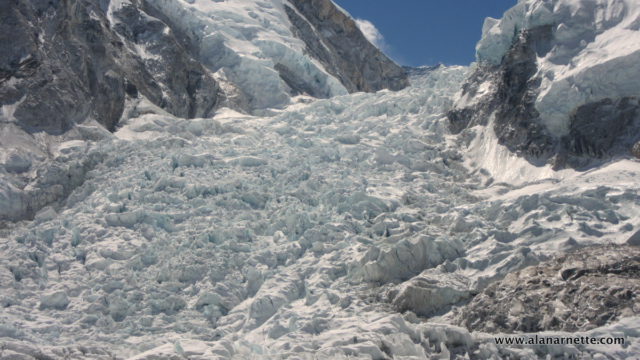 Khumbu Ice Fall from EBC
Khumbu Ice Fall from EBCThe Khumbu Icefall is legendary in mountaineering. In modern times it has an infamous reputation causing many guides to refuse to let staff and clients go through it fearing the ice release off Everest’s West Shoulder. Many guide companies have switched to the Tibet side of Everest feeling it is safer. George Mallory, while seeking a route to climb to the summit of Everest in the 1920s, noted the Icefall was “terribly steep and broken … all in all, the approach to the mountain from Tibet is easier,” thus shifted his efforts to Tibet. He disappeared on his infamous attempt from the Tibet side in 1924.
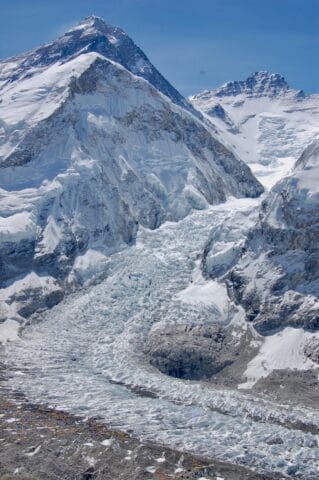 The Khumbu Glacier begins at the foot of Lhotse and defines the Western Cwm. For about 2 miles it drops rapidly to create the Khumbu Icefall for 2.5 miles. Around Everest Base Camp, the glacier makes a sharp southernly bend and continues for another six miles to 16,000-feet. The Icefall varies in width from over half a mile to a third of a mile.
The Khumbu Glacier begins at the foot of Lhotse and defines the Western Cwm. For about 2 miles it drops rapidly to create the Khumbu Icefall for 2.5 miles. Around Everest Base Camp, the glacier makes a sharp southernly bend and continues for another six miles to 16,000-feet. The Icefall varies in width from over half a mile to a third of a mile.
Like other similar glaciers, the Khumbu moves as much as 3-feet a day. It goes faster in the center while barely moving at the edges due to friction against rock walls. Also, the surface of the glacier moves more quickly than the bottom due to friction against the earth. It is this dynamic of fast and slow-moving sections plus the precipitous drops that create the deep crevasses, some over 150-feet deep, and towering ice seracs over 30-feet high.
It is the highest glacier on earth. It is estimated to be retreating about 65-feet per year and has shrunk about 3,100-feet between the 1960s and 2001. Between 1962 and 2002, the Icefall thinned by an average of 56-feet, about a rate of 1.3-inches per year.
The glacier has thinned by 40-50-feet over most of the length. Everest Base Camp is lower today due to the ice melting. In 1953 when Hillary and Tenzing summited, EBC was about 17,454-feet; today, it is 17,322-feet.
The team left on time at 4:00 am, stomachs half-full of toast, porridge, eggs, and coffee. It was hard to eat a lot. They walked by the Puja Altar, where Dawa had lit juniper boughs. Each person, except for one, stood silent at the Altar before sweeping their open palm into the smoke, bringing it towards them with the blessed smoke. They did this three times. The boughs would smolder until the climbers returned.
The walk to Crampon Point seemed shorter this time. They found the end of the fixed rope and clipped their jumar onto it. This time Buddies took the lead with their Personal Sherpas; She was content to stay in the middle of the pack with Dutch, Snorer, the Couple. Old Man was bringing up the rear with Guide sweeping the team.
Their headlamps lit up the area just in front of their boots, but as the sun rose, there was just enough ambient light, so the headlamp was a placebo. After only ten minutes, they found themselves breathing as if they had just run the fastest mile in history.
Dutch paused, his hands on his knees. “What’s going on?” He asked himself, privately trying not to show the stress. His Personal Climbing Sherpa looked over his shoulder, “Bistari, bistari, slowly, slowly Mr. Dutch.” He was pushing too hard, going too fast out of the gate. He needed to pace himself.
About now, they heard voices behind them, a Sherpa train. They stepped aside as ten Sherpas, each with a pack overflowing with pads, oxygen bottles, white sacks holding who knows what went by. They seemed to be running and talking and laughing. They were having a great time. She wondered how they could muster such enthusiasm.
Clipping back into the fixed rope, they continued to climb. All of a sudden, the team found their rhythm; they got their cadence, their pace, their style. Their breathing calmed down. For the first time, Snorer looked around. Ice, nothing but ice. The boot track was clear ahead; the white nylon line was like a shed snakeskin as it disappeared into the cracked ice blocks.
An hour into the climb, the steep initial pitch of the Icefall eased a bit. Time for a break. As they sat on their packs, drinking water, they tried to huff down an energy bar. No one was really hungry, but they knew better and forced something down along with water.
Instead of looking up, Snorer looked down. Base Camp. The tent city was widespread. He instinctively looked for their camp, his tent, a connection with something he knew instead of this world of uncertainty, of the unknown ahead. Sighting their tents, he relaxed, but then it dawned on him how high he was, yet he had hours to go to reach camp.
This pattern repeated every quarter-hour for the next four hours. One step at a time, they crossed ladders, clipped onto and off of the fixed ropes. Snorer swore at each anchor that required him to unclip the carabiner, perhaps the jumar. Why were the anchors so close together? A rhetorical question.
Grouping together, the team took breaks at the well-known features – the popcorn, the football field, the prayer flags – roadsigns and weigh stations along an icy highway they had memorized in their mind from years of reading books on Everest. They expected that at each spot it would be familiar, an old friend, but each one was drastically different from what they had envisioned.
As the morning progressed, so did the traffic. They were now at ease with stepping aside to let Sherpas pass going up and coming down. She quietly offered a “Namaste” to each one; they responded in kind. Even Old Man was starting to feel good. Glancing at his watch, it was 8:00 am. Quickly, he tried to do the math. How far had he come, how far to go. “Are we close?” He asked Guide.
The Icefall ahead appeared to crest. “False top.” Old Man offered the group. “Tricked me last year.” The Buddies were already there, at the mirage, but closer to their tent, their mat, their sleeping bag. They were moving well.
Ladders, more ladders, but these were different. They went straight up. “This wasn’t in the brochure,” Dutch joked. The Icefall terrain had changed, instead of a steady increase in grade, it now went drastically down and back up. It was a sign that the top was close.
The Icefall, literally “falls” over the lip and into a rocky ravine buried under hundreds of feet of moving ice. Now the ice seemed to rise like a big city skyscraper. Their legs started to complain. They questioned the decision last night to pack that book, even though it weighed less than that extra pair of socks they added at the last minute.
Using the ladders required concentration. The crampons hitting the aluminum rungs made a tinny, metallic noise. Dutch found it comforting. He knew each step was stable, and he was closer to C1. The thin nylon fixed-line was their consent companion.
Nearing the actual top of this section, they approached an ice wall. There were two separate vertical ladder configurations; each consisted of four ladders lashed together with the same thin, white nylon rope.
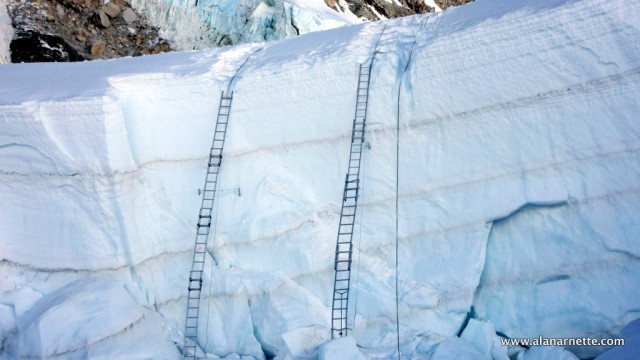 Ladders at the top of the Khumbu Icefall in 2015 before the earthquake
Ladders at the top of the Khumbu Icefall in 2015 before the earthquakeOld Man had slowed down. He was far behind the rest of the pack. Buddies were already at Camp 1.
“Any advice?” He asked Guide, who had been close by his side the entire morning. “Slow, steady, and make sure you are always clipped in. No need to rush. We are making good time.” Old Man appreciated the positive spin.
They cleared the ice wall and stepped onto the Western Cwm proper. She expected to see Camp 1, but it was still half an hour away. The sun was blinding. She had made a mistake by not putting her sunglasses on when Mingma did. She wouldn’t make the same mistake again. Quickly, She took off her pack and retrieved her glasses. Snow blindness was a risk at this altitude.
 Western Cwm
Western Cwm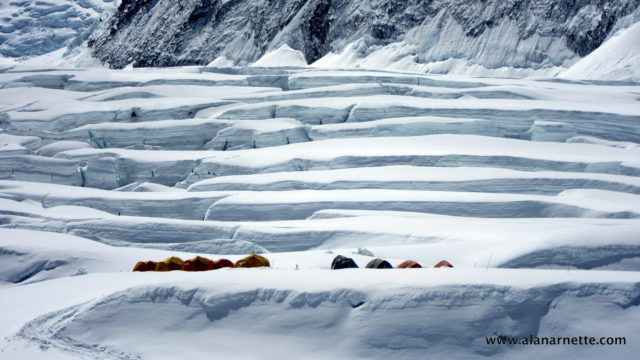 Camp 1 in Western Cwm
Camp 1 in Western CwmThey set a smooth and steady pace across a labyrinth of shallow crevasses. Some were only a few feet deep others a bit more. But, it took precious energy, and She was running low. She looked up, expecting to see the South Summit of Everest, the Lhotse Face, but there was nothing, only an expanse of wrinkled snow. It looked like a slept-on white bed sheet.
They moved, climbed, gained elevation until the mirage of C1 became real, a yellow speck in the distance, and another, and another.
A line of tents! Camp 1!!
Climb on!
Alan
Memories are Everything
Climbing Sherpa Support
Who, how much, and how often you donate is a personal decision. Maybe you climbed with one of the guides, or plan to one day. Perhaps you have followed them for years and want to support their Climbing Sherpa team, or maybe you support by geography – Nepali, American, Austrian, British, New Zealand. It’s up to you and will be much appreciated.
My sincere appreciation to those companies who accepted my invitation to join Virtual Everest 2020 – Support the Climbing Sherpas
- Alpine Ascents International: Click to Donate to Alpine Ascents’ Climbing Sherpas
- Adventure Consultants: Click to Donate to Adventure Consultant’s Climbing Sherpas
- Alpenglow Expeditions: Click to Donate to Alpenglow Expedition’s Climbing Sherpas
- Furtenbach Adventures: Click to Donate to Furtenbach Adventure’s Climbing Sherpas
- International Mountain Guides: Click to Donate to IMG’s Climbing Sherpas
- Jagged Globe: Click to Donate to Jagged Globe’s Climbing Sherpas
- Madison Mountaineering: Click to Donate to Madison Mountaineering’s Climbing Sherpas
- Mountain Professionals: Click to Donate to Mountain Professional’s Sherpas
For an overview of the Virtual Everest 2020 – Support the Climbing Sherpas, please visit this post.
Previous Virtual Everest 2020 posts:
- Virtual Everest 2020 – Support the Climbing Sherpas
- Virtual Everest 2020: Leaving Home
- Virtual Everest 2020: Flying at the Summit of Everest
- Virtual Everest 2020: Weekend Video Update April 5
- Virtual Everest 2020: Hello Kathmandu!
- Virtual Everest 2020: Kathmandu
- Virtual Everest 2020: Exploring Kathmandu
- Virtual Everest 2020: The First Team Dinner
- Virtual Everest 2020: Lukla Drama
- Virtual Everest 2020: The Trek Begins
- Virtual Everest 2020: Weekend Video Update April 12- Guy Cotter Interview
- Virtual Everest 2020: Everest View
- Virtual Everest 2020: Blessing in the Khumbu
- Virtual Everest 2020: Leaving the Trees
- Virtual Everest 2020: Remembering
- Virtual Everest 2020: The Trekker’s Summit
- Virtual Everest 2020: April 18, Honoring the Fallen
- Virtual Everest 2020: Weekend Video Update April 19- Gordon Janow Interview
- Virtual Everest 2020: Settling into Base Camp
- Virtual Everest 2020: Puja at Base Camp
- Virtual Everest 2020: It Takes a Village
- Virtual Everest 2020: First Steps in the Khumbu Icefall
- Virtual Everest 2020: Weather Day and Tough Conversations



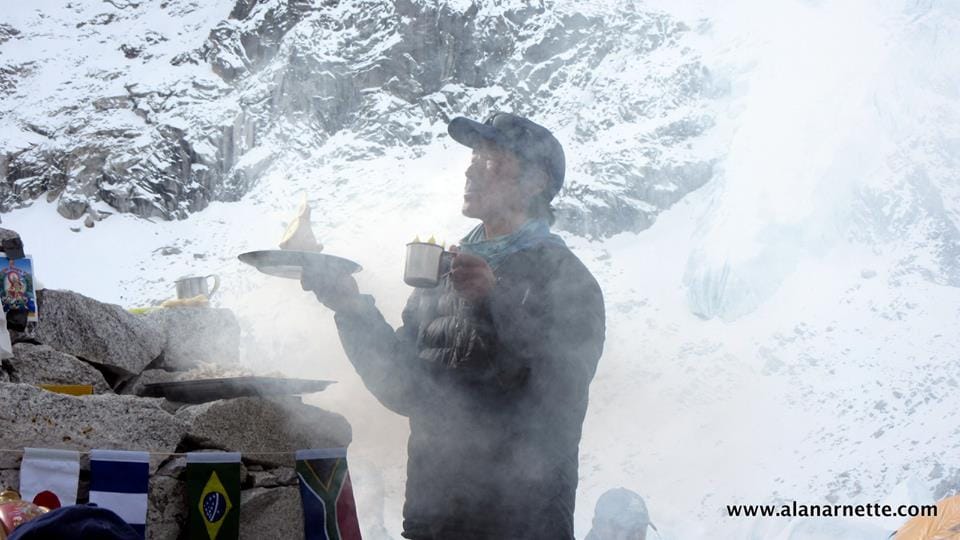
4 thoughts on “Virtual Everest 2020: Climbing to Camp 1, and 5 Years Later”
The closest I’ll get but it’s like being there with courageous friends. Thanks beyond words …Following your blogs has been an annual commitment and joy for years and your memories mean everything!
Thanks, Cristan!
Just a quick comment to say how much I am enjoying this tale. It’s very informative too. Keep up the good work Alan!
(I can’t help it though … the angel on my shoulder says I hope they all summit … the devil on my other shoulder wonders who the affair will be with … Dutch, Loner or Old Man?)
Thanks, Outsider! I sincerely appreciate the comment. Perhaps I should run a lottery on the affair with the proceeds going to the Climbing Sherpas! On the other hand, I’m trying desperately not to turn this into a Harlequin novel! 🙂
Comments are closed.